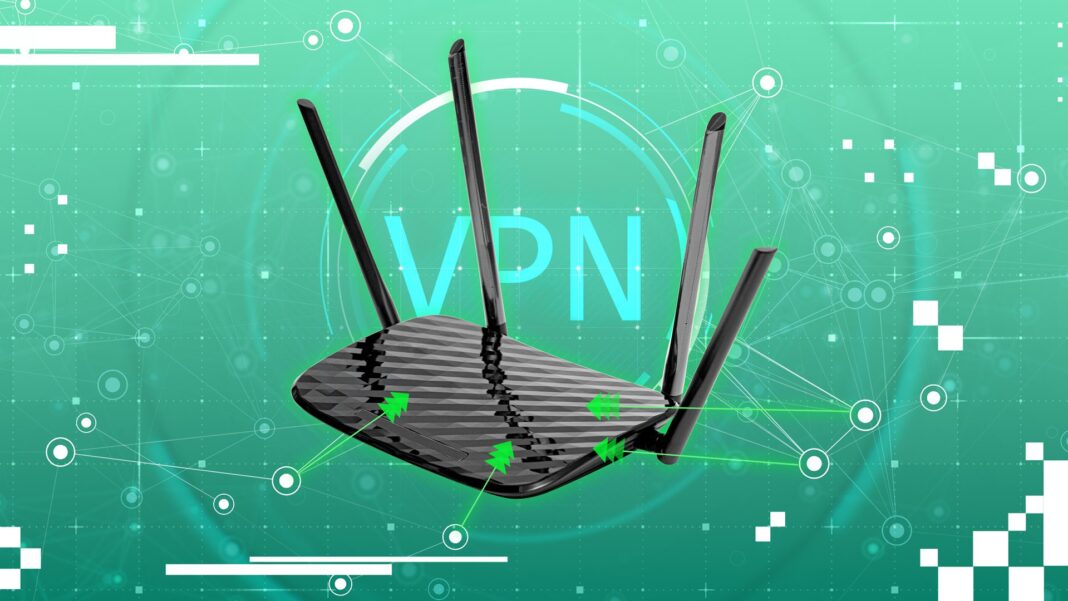It can be a pain to go through every single device you have and connect them to your virtual private network (VPN), even if most services give you ample simultaneous device connections these days. Guests may want to connect to your Wi-Fi, and you’ll have to share your login information if you want to secure their devices. That issue grows exponentially if you consider a small office with frequent clients and workers who handle sensitive data. Installing a VPN on your router solves that headache by automatically routing all of your traffic through an encrypted tunnel. It also takes away human error by ensuring you don’t have to remember to connect to a server every time you use a device.
Do You Need a VPN on Your Router?
If you’re looking to install a VPN on your router, then the odds are that you already know the basics of what a VPN does and how it works. Encrypting your entire network without needing to painstakingly log in and log out of every device is a huge plus. You can set it and forget it in your home, office, or studio so that you connect the same way each time without any necessary input. However, the main drawback is that you’ll need to go into your router’s settings every time you want to change the location or configuration. It also gets complicated if you want different devices on that network to connect to various server locations instead of having all of them route through the same place.
The Best VPNs We’ve Tested
Should You Buy a Router With a Built-In VPN?
Flashing a VPN to a router isn’t easy. It takes a lot of patience, and you need to be comfortable with software in general. Fortunately, you can get a router with a built-in VPN client. Aircove by ExpressVPN is one of the most popular offerings, though you have to use ExpressVPN and have an active subscription to get the most out of it. If you don’t want to lock yourself into a specific provider, then you can go with a model that has preconfigured firmware for connecting to OpenVPN.
The price for these pre-flashed routers has come down quite a bit in recent years, so it’s no longer a matter of an exorbitant price or a cheap configuration. Unless you already have a router you would like to add a VPN to, then you’ll likely save yourself money and time by going with a router that at least has OpenVPN support. We’ll talk more about how DD-WRT works below, but even the team behind it offers pre-flashed routers courtesy of Flashrouters to get you started in the right direction.
However, don’t let that deter you if you think installing a VPN on a router is a fun project. Despite there being more convenient options these days, there’s still value in knowing how the whole installation process works.
What Is DD-WRT?
The router you got from your internet service provider (ISP) likely won’t support you installing software on it. The same is going to be true for most routers you get off the shelf. You might get lucky and find one that supports OpenVPN or Point-to-Point Tunneling Protocol (PPTP), but these features aren’t something most regular consumers are looking for. You need to look beyond basic consumer options and at more premium routers before you start to see support for VPNs.
Without shelling out for another device, you’ll need to hunt for an alternative firmware that’ll support either OpenVPN or your chosen VPN client. It’s a bit dated, but the go-to option is DD-WRT, though another one is Tomato if you have a Broadcom-based router. DDD-WRT works on more routers, including older devices that you may have collecting dust. You can check to see if your router is supported here. Despite the age of the software, that compatibility list is still being updated.
Depending on your comfort level and the amount of e-waste sitting in your garage, you can turn an old x86 PC into a router by adding an extra network port via an expansion card and then installing DD-WRT on that. It’s not the easiest task, but it’s a great way of breathing new life into an old computer while getting the added benefit of a capable and customizable router.
If that undertaking isn’t feasible for you, then you’ll want to stick to installing DD-WRT on a compatible router. The only downside of using your router this way is that you can void your warranty, or worse, render the router completely inoperable if things go wrong. The best way to avoid this is to make sure you’re installing DD-WRT on a router that’s not only supported (check that link above), but has been supported for a good long while, too.
If you’re not feeling confident, it’s worth finding a support forum with users familiar with both your router and DD-WRT. It’s likely that someone has tried this before with the same router, and you can avoid repeating their mistakes by researching the process ahead of time. Some router manufacturers have such forums on their support pages, but more often you’ll find them in independent web locations, such as the main DD-WRT website or Reddit.
Once you have those resources in place, follow our instructions to upgrade your router below.
How to Find Your Router Configuration
Every router is a little bit different, but most Linksys routers follow a similar pattern when it comes to login and making changes to the configuration. That process is also similar to what you’ll find on most other router brands, too, so it’s a good example for this article.
Step 1: Figure out your router’s Internet Protocol (IP) address. To do this on Windows, click the Start menu, type in CMD, and click Enter. In the window that appears, type in ipconfig and click Enter again. You should see the same thing as in the screenshot below, though with different address numbers. Your router’s IP address will be listed as the Default Gateway. Here, that’s 192.168.13.1.
(Credit: PCMag)
Step 2: Open your browser and type in your router’s IP address as the URL. For example, ours is (http://192.168.13.1). You’ll be prompted for your router’s admin login and password. You can look up your router model on the Linksys website to find the default credentials. If it’s not Linksys, then just find your original installation instructions. If that document is long gone, then head over to your router maker’s website and find the instructions for setting your router back to factory defaults. The default credentials should be there, too. If that doesn’t work, you’ll need to call your router’s support line and ask.
Get Our Best Stories!
Get the Most Out of Your Technology
By clicking Sign Me Up, you confirm you are 16+ and agree to our Terms of Use and Privacy Policy.
Thanks for signing up!
Your subscription has been confirmed. Keep an eye on your inbox!
Step 3: Once you get access to the router’s administrator functions, you’ll want to find the console that allows a firmware update. Generally, this will be found under the Administration tab. For specific instructions for Linksys routers, check here. Other router vendors will have similar instructions available on their support pages.
(Credit: PCMag/Linksys)
How to Download and Install DD-WRT on Your Router
There’s a lot to this process, and it can be easy to breeze by steps without too much focus. However, I implore you to slow down here and make sure you understand the whole process before proceeding, as this is the place where you can potentially break your router if you do it wrong. Most installs go just fine, but it’s good to prepare your environment, as a random power outage or breaker trip could result in your router blipping its final blip. Make extra sure that you choose the right files below for your specific router, as a mismatch could also result in the worst-case scenario.
Step 1: Navigate to this page and enter your router’s model name. You’ll get a list of potential candidates. Pick the one that matches your router’s brand and model number, and then download the bin file.
(Credit: PCMag/DD-WRT)
Step 2: From the Firmware Update screen on your router, upload the bin file and wait. If everything worked the way it should have, then you will have a router that’s running DD-WRT and is therefore compatible with OpenVPN. Don’t panic if this doesn’t happen. I ran into this error when I tried upgrading the Linksys LAPAC1200 Access Point. Go to this page and follow the instructions exactly. With any luck, you’ll get back to a good starting place to try again.
(Credit: PCMag/DD-WRT)
Step 3: Once everything lights up the way it’s supposed to, the default IP address of a new DD-WRT install is http://192.168.1.1. Again, enter that address into your PC’s web browser as a URL.
Recommended by Our Editors
Step 4: You’ll be prompted to reset the default username and password. After that step, you can move on to the basics of your new router’s configuration process. For business users and those with more advanced network requirements, DD-WRT offers a lot of advanced possibilities, so running through everything is beyond the scope of this article. But for most home and small business implementations, you will need to set the connection type for your wide area network (WAN), which really means your internet provider. Generally speaking, this will usually be found under the Dynamic Host Configuration Protocol (DHCP), so if you aren’t sure, that’s a good place to start.
(Credit: PCMag/DD-WRT)
Setting Up the VPN Client on Your Router
The tough part is over. The danger zone is behind you if you’ve successfully installed DD-WRT and verified that your router is still communicating with the internet. Only continue with the VPN installation if the router is fully functional and connected.
Step 1: Navigate to the VPN tab under Services in your DD-WRT settings.
Step 2: Check the Enable Bubble next to “Start Open VPN Client.”
Step 3: At this point, there is no universal set of instructions. The settings will be completely unique to the VPN provider.
However, several VPNs have ready-made instructions for DD-WRT configuration. NordVPN has instructions here, for instance. Some VPNs will want to install their software, while others will want to use OpenVPN. Just follow the instructions for your VPN to stay on track.
(Credit: PCMag/DD-WRT)
DD-WRT’s status tab will show you if you’re connected to your VPN. To be doubly sure and to check for any DNS leaks, you can check your IP by typing “What is my IP?” into Google.
If it worked, then you should get something different from what you started with, since you should be connected to your VPN’s servers. If that happens, great job! You can now browse the web with more anonymity on all of your connected devices. If not, run back through the steps above and make sure everything was done correctly.
Daniel Brame contributed to this article.
About Justyn Newman
Senior Security Analyst















